
Symptoms of cervical osteochondrosis are currently considered very common. This disease is diagnosed in people of absolutely any age and in most cases is observed in able-bodied citizens aged 30 to 50 years. Some patients do not suffer from symptoms of cervical osteochondrosis without even suspecting malaise, as degenerative changes in the cervical spine can occur unnoticed. During treatment, a person can return to excellent health. However, the appearance of the first symptoms of cervical osteochondrosis should not be overlooked. That is why it is worthwhile to get acquainted in more detail with the signs of this disease.
Symptoms of cervical osteochondrosis
This disease may not appear at all in the initial stage of its development. The symptoms of osteochondrosis of the cervical spine are felt only in the advanced form of the disease in the form of frequent headaches, which intensify during the movement of the neck. When cerebral circulatory disorders are observed during cervical osteochondrosis, the patient begins to show the following symptoms of the disease:
- constant headaches;
- increased fatigue;
- impaired sensitivity of facial muscles;
- noise in the head;
- high blood pressure;
- ringing in the ears;
- hesitant gait;
- frequent dizziness;
- loss of coordination in space.
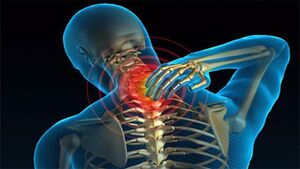
If the disease is chronic, the symptoms and pain of cervical osteochondrosis will be permanent. In this case, any movement of the head will be difficult due to the tension of the muscles of the neck. Symptoms of chronic osteochondrosis of the cervical spine manifest themselves in the form of migraine, headache, which in some cases is accompanied by nausea, vomiting and even loss of consciousness. If you do not start treatment on time, then the patient begins to be accompanied by pharyngeal symptoms. These symptoms of cervicothoracic osteochondrosis of the spine include: a feeling of dryness in the throat, difficulty swallowing, tickling and itching. After some time, this disease can cause a hernia in the area of the intervertebral disc. Therefore, when the first signs and symptoms of osteochondrosis of the cervical spine appear, treatment should be immediate. It is worthwhile to get acquainted in more detail with the most effective methods of treatment of this disease.
Causes of osteochondrosis
The main reason for the development of osteochondrosis in the neck is the aging of the human body and is also associated with age-related changes that occur in the tissues. But there are some factors that increase the risk of developing this pathology. These factors include:
- Sedentary work and sedentary lifestyle.
- Long stay in the same static position.
- Overweight.
- Nervous load and frequent stress.
- Common hypothermia.
- Autoimmune diseases in which cartilage tissue suffers.
- Injuries to the nape of the neck.
- Abnormal congenital structure of the vertebrae.
In addition, heredity, hormones and metabolism play an important role in the development of this disease.
Methods of treatment of cervical osteochondrosis
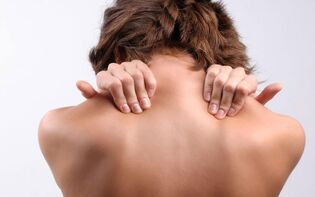
To get rid of the signs and symptoms of osteochondrosis of the cervical spine, treatment involves a range of methods and tools aimed at eliminating pain and combating the inflammatory process that occurs in the tissues. Daily physical activity and exercises aimed at flexibility of the spine are considered very effective. The program for such loads must be individual, it is selected by a specialist only after performing diagnostic measures using computed tomography or MRI. When the first signs and symptoms of cervical osteochondrosis appear, the doctor should also prescribe treatment. But what is the basis for the treatment of this disease?
Medicine
When the first symptoms of cervical osteochondrosis and headache appear, drug therapy is prescribed. First, the pain is relieved with conventional painkillers. However, it is worth paying attention to the fact that this method will be effective only in the initial stage of the disease. After that, the pain pills are no longer useful.
Drug therapy for cervical osteochondrosis involves the use of a new generation of chondroprotectors, which are drugs that stimulate the recovery of cartilage in the spine. The best therapeutic effect is the combination of chondroitin sulfate and glucosamine. The course of such therapy is usually several months, after which there is an improvement in the mobility of the cervical spine.
And how to relieve acute muscle and headache in cervical osteochondrosis? Symptom data can be eliminated with the use of novocaine blockade or nonsteroidal anti-inflammatory drugs. This should include capsules, ointments, injections and tablets that can quickly improve the patient's general condition. If these chondroprotectors have no contraindications even with prolonged use, then these contraindications are very serious for nonsteroidal anti-inflammatory drugs, so their use should be agreed with your doctor.
Ointments and gels
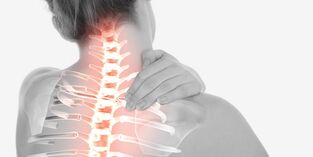
When the first signs and symptoms of cervical osteochondrosis appear, treatment at home can be carried out with the help of special ointments or gels, which begin to act 10 minutes after application on the problem area. These funds are divided into several types, which include:
- Anti-inflammatory external agents based on non-steroidal substances that can eliminate painful sensations.
- Regenerating ointments and gels that repair damaged cartilage between the vertebrae.
- Anesthetic external ointments and gels that can quickly affect the nerve endings while dulling the pain.
- Various massage ointments.
Manual therapy
Of course, treating the symptoms of cervical osteochondrosis at home through manual therapy will be quite difficult. However, this method is very effective and the most ancient. Specialists have developed many different techniques that can have a beneficial effect on the vertebrae, joints and tissues of the affected areas. When choosing a chiropractor for yourself, it should be noted that he must be an excellent specialist, otherwise an inexperienced person in this matter can lead the patient to a wheelchair. The main methods of manual therapy to combat osteochondrosis of the cervical spine are as follows:
- Manipulations that are aimed at restoring the health and functioning of the joints. These manipulations are accompanied by their crisis.
- Segmental massage that can relieve muscle tension.
- Mobilization that repairs damaged joints by traction.
Acupuncture
How else can you eliminate the signs and symptoms of cervical osteochondrosis of the spine? Acupuncture treatment can not only eliminate the pain during this disease, but also completely cure it. This technique of needle therapy came to our medicine from the eastern countries. The wise Chinese, armed with philosophy as well as knowledge of the human body, have figured out how to regulate the energy in the body with the help of metal needles. This procedure is now officially recognized by doctors as an effective technique to combat osteochondrosis.
Before getting rid of the symptoms of osteochondrosis of the cervical and thoracic spine with the help of acupuncture, it is mandatory to consult a specialist, as this procedure is not suitable for every patient. This technique is not performed in the following cases:
- during pregnancy;
- for existing infectious diseases;
- if there is a tumor;
- for skin or blood diseases;
- in infancy or old age.
Homeopathic medicines
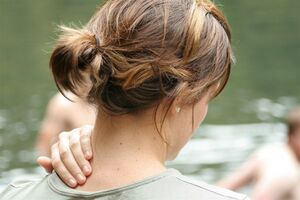
Homeopathic remedies are very effective in combating cervical osteochondrosis. Homeopathic medicines contain biologically active substances and useful microelements. These substances absolutely correspond to the concentration of minerals and vitamins in the human body. Homeopathic medicines contain herbal extracts, plant extracts that are taken only from ecologically clean specimens. And the main advantage is that such preparations are completely natural. The main principle of the effect of these drugs in osteochondrosis is as follows:
- restoration of cartilage tissue;
- activation of human immunity;
- improve blood circulation in the collar area.
Home treatment
It is now possible to treat the symptoms of cervical osteochondrosis at home. To alleviate the pain and achieve general improvement in the patient, it is necessary to adhere to a special diet and also lead an active lifestyle. The daily diet of a patient diagnosed with cervical osteochondrosis should include foods that promote cartilage regeneration. These products include the following:
- fresh vegetables and fruits, as well as cereals and legumes;
- products that contain a large amount of protein: low-fat fish and poultry, eggs, nuts;
- foods containing unsaturated fatty acids, such as sea fish or flaxseed;
- foods rich in calcium, such as leafy vegetables, cottage cheese, milk.
Massage
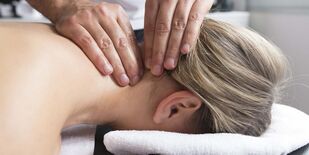
Successful home therapy can also be done with massage or self-massage. This procedure relieves tension and relaxes tight neck muscles. After self-massage in the intervertebral discs, the blood circulation improves, due to which there is a quick relief. The self-massage procedure itself should be performed in a sitting position and during it stroking, rubbing and kneading movements are made on the nape of the neck. However, to achieve maximum effect, it is best to use the services of a professional.
Conducting healing gymnastics
Such therapeutic exercises have no less effect than drug therapy for cervical osteochondrosis. Many experts say that healing gymnastics is the basis for the patient's recovery. Such exercises, as a rule, do not take much time, especially since they are quite easy to do at home. This exercise helps to relieve pain syndromes during cervical osteochondrosis. It also stretches your ligaments and relaxes the neck muscles. However, it is necessary to perform any actions during such gymnastics only after consultation with a specialist. They must be performed very carefully so that the patient does not harm his body.
Kuznetsov applicator
Acupuncture is a very effective treatment for this disease. However, not every patient decides on acupuncture. For the purposes of home therapy, an alternative device is used, which is a Kuznetsov needle applicator. It has single or double needles located on the neck roll or on the buckle belt. If the patient lies on this applicator for 30 minutes every day, then it is possible not only to significantly alleviate the symptoms, but also to completely overcome this disease.
Folk recipes

There are many effective recipes for alternative medicine with which you can get rid of cervical osteochondrosis. Herbal treatment is very economical, effective and most importantly - safe. To do this, you do not need to buy some expensive pain medications. In addition, many drugs purchased at the pharmacy can have side effects and contraindications, which can not be said about the prescriptions of traditional medicine. The following natural remedies can help with osteochondrosis of the cervical spine:
- Horseradish leaves. To do this, you need to attach a leaf of this plant to the back of the neck, fixing it with adhesive plaster at night. As a rule, the painful sensations disappear by morning.
- Potatoes. This vegetable should be grated together with honey in equal proportions. The resulting mixture should resemble an ointment in its consistency. Finished product in the form of a compress is used at least once every 7 days.
- Compress made from one liter of vodka, 1 tablespoon of freshly squeezed aloe juice, 1 tablespoon of mustard powder and 50 g of propolis is quite effective. All ingredients are mixed, then the resulting mixture is impregnated with gauze or cloth, applied to the neck area and fixed with a woolen cloth. It is recommended to make such compresses 1-2 times every 7 days. Compresses are made at night.
Disease prevention
Many people know that a disease is easier to prevent than to cure. Prevention of osteochondrosis includes maintaining proper posture, simulator exercises, fitness exercises, walking, swimming and yoga. While reading or writing, one should not lean too low over the table, and while sleeping, it is best to use orthopedic pillows.
Patient feedback
Opinions of patients who have been diagnosed with osteochondrosis show that it is not so difficult to cure this disease at home. However, a greater effect can be achieved if you use a complex therapy that includes not only massage and folk remedies, but also the use of drugs.
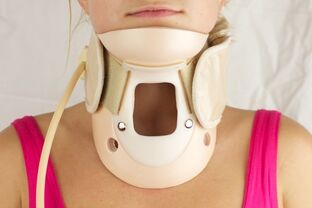
In conclusion, it should be noted that osteochondrosis of the cervical spine is a very common disease at the moment. This disease affects not only the elderly but also young people due to an inactive and sedentary lifestyle. However, this disease can be successfully treated. To do this, when the first symptoms and signs appear, you should seek help from a medical institution, where a specialist will prescribe the appropriate treatment. It is also worth remembering that the use of prescriptions from traditional medicine is recommended to be agreed with your doctor.

























